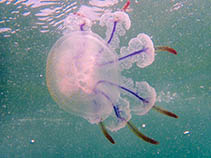Anomalorhiza shawi Light, 1921
Warning: DOMDocument::load(): SSL operation failed with code 1. OpenSSL Error messages: error:140770FC:SSL routines:SSL23_GET_SERVER_HELLO:unknown protocol in C:\Apache24\htdocs\includes\SpeciesSummary.lib.php on line 1236
Warning: DOMDocument::load(): Failed to enable crypto in C:\Apache24\htdocs\includes\SpeciesSummary.lib.php on line 1236
Warning: DOMDocument::load(https://sealifebase.nrm.se/webservice/AquaMaps/getAMap.php?genus=Anomalorhiza&species=shawi): failed to open stream: operation failed in C:\Apache24\htdocs\includes\SpeciesSummary.lib.php on line 1236
Warning: DOMDocument::load(): I/O warning : failed to load external entity "https://sealifebase.nrm.se/webservice/AquaMaps/getAMap.php?genus=Anomalorhiza&species=shawi" in C:\Apache24\htdocs\includes\SpeciesSummary.lib.php on line 1236
Classification / Names Common names | Synonyms | CoL | ITIS | WoRMS
| Rhizostomeae | Lychnorhizidae
Environment: milieu / climate zone / depth range / distribution range Ecología
Pelágico. Tropical
Distribución Países | Áreas FAO | Ecosistemas | Ocurrencias, apariciones | Introducciones
Pacific Ocean.
Length at first maturity / Tamaño / Peso / Age
Maturity: Lm ? range ? - ? cm Max length : 60.0 cm WD macho / no sexado; (Ref. 2992)
Short description Morfología
60 cm wide, flat, exumbrella with low, wart like projections in central part; in each octant six velar lappets, slightly convex, the two lateral smaller; mouth-arms branched only near the tip, the entire outer surface quite bare; mouths surrounded by tiny filaments; near center of disk very small, slender filaments; each arm terminates in a long, slender club; inter-rhopalar canals end at ring canal; between the 26 radial canals only one intracircular canal.
Life cycle and mating behavior Madurez | Reproducción | Puesta | Huevos | Fecundidad | Larva
Members of the class Scyphozoa are gonochoric. Life cycle: Egg is laid by the adult medusa which later develops into a free-living planula, then to a scyphistoma to a strobila, and lastly to a free-living young medusa.
Main reference
Referencias | Coordinador | Colaboradores
Kramp, P.L. 1961. (Ref. 2992)
IUCN Red List Status (Ref. 130435)
CITES status (Ref. 108899)
Not Evaluated
CMS (Ref. 116361)
Not Evaluated
Threat to humans
Human uses
| FishSource |
Herramientas
Más información
Países
Áreas FAO
Ecosistemas
Ocurrencias, apariciones
Introducciones
Stocks
Ecología
Dieta
componentes alimenticios
Áreas FAO
Ecosistemas
Ocurrencias, apariciones
Introducciones
Stocks
Ecología
Dieta
componentes alimenticios
Fuentes de Internet
BHL | BOLD Systems | CISTI | DiscoverLife | FAO(Publication : search) | Fishipedia | GenBank (genome, nucleotide) | GloBI | Gomexsi | Google Books | Google Scholar | Google | PubMed | Árbol de la vida | Wikipedia (Go, búsqueda) | Expediente Zoológico
Estimates based on models
Price category
(Ref. 80766):
Unknown.



